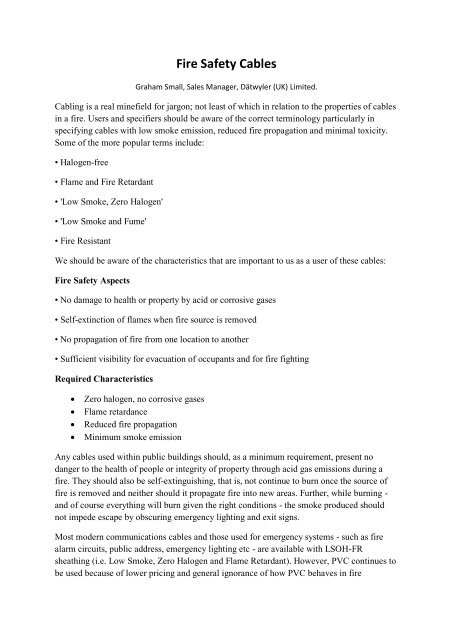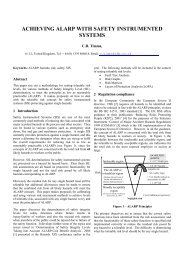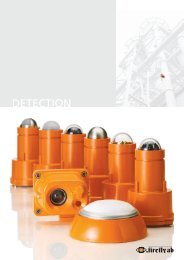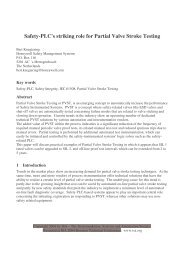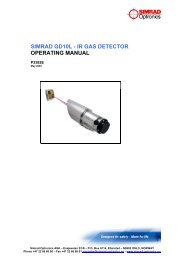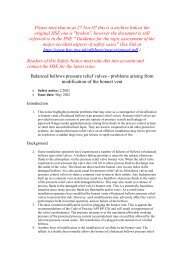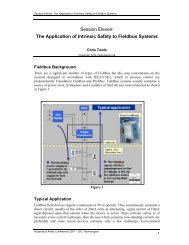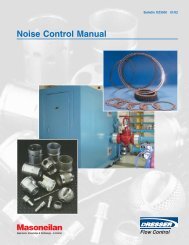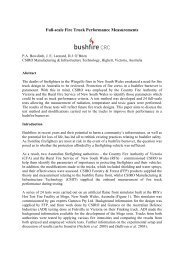Fire Safety Cables - ICEWeb
Fire Safety Cables - ICEWeb
Fire Safety Cables - ICEWeb
Create successful ePaper yourself
Turn your PDF publications into a flip-book with our unique Google optimized e-Paper software.
conditions. Internal cabling favours PVC instead of polythenes and rubbers because unlikethese other materials they will quickly extinguish themselves once the source of fire isremoved or extinguished. Unfortunately, the halogens in PVC that exhibit this propertyproduce corrosive by products such as hydrochloric acid that is fatal both to humans andsensitive electrical equipment as found in computers for example. Even quite small fires canproduce enough acidic fall-out to destroy electronic equipment in buildings.After 5-7 minutes opaque smoke from an LSOH-FR cable will cause a peak 15%deterioration in light transmission settling to around 5% compared to a 90% deteriorationover an extended period for PVC sheathed cable.The majority of standard building cable used in the UK - even where LSOH-FR types areinstalled - will lose their functionality in a fire very quickly. That means that even if the cableposes no threat or hazard to people or building systems they will cease to provide a circuitquite quickly. Therefore, emergency systems such as public address, lighting, heat and smokeextraction and special lifts for fire-fighters need to be protected to ensure they will continueto function for a period of time during a fire.The fire resisting property of cable is measured in the UK by British Standard BS6387. Thistakes a 600mm length of cable and subjects it to a flame of 950°C for 3 hours while carrying3 amps of current. The specification also emulates fire conditions by subjecting the burningsample to water spray and mechanical shock (categories C, W and Z respectively). A furtherspecification - BS7629 - combines this fire survivability with low smoke and toxicityemission. Similar tests exist in Europe, such as IEC 60331 that concentrate on fireperformance only.Traditionally, fire-resisting cables such as MICC (mineral insulated, copper clad) have beenused to provide robust links in fire protection systems. Often described as 'fire survival'cables they utilise mineral-based insulation and copper tube technology. Although suchcables are of a high quality and robust, they are more difficult to install than alternatives.Several years ago, a 'soft skin' approach to fire-resistant cables was introduced. Such cablesare more akin to those usually installed by electrical contractors. They use thermoplasticmaterials and fire resisting tapes, rather than copper tube technology. Clearly these cablesoffer a more flexible design and are easier to install. They do not require such highly skilledtechnicians to install them since the required installation techniques are little different fromthose employed on lighting circuits.Both solutions have their merits. The consultant or fire engineer has to weigh up therequirements of each specific installation, balancing the need for effective safety criticalcircuits (that will facilitate evacuation and property protection) against the available budget.A further issue relates to the way in which the standard tests the cable. At present, only powertransmission performance is assessed. This needs to be amended to address the datatransmission performance. This is all-important for modern addressable fire detection andalarm systems.
However, current fire-related cable standards deal only with the combustion of cables andnot with the continued functionality of the life and property protection systems theyinterconnect. UK standards such as BS6387 and BS7629 seek to ensure that cables used infire detection and alarm circuits (BS5839) and emergency lighting (BS5266) for examplemeet fire resistance, smoke and toxicity emission's and propagation criteria. Even the 'newbreed' of composite 'EN' standards, such as EN50200, addresses these issues from acomponent-based viewpoint. As these standards do not emulate the thermal and dynamicstresses on cable and its supporting infrastructure during fires the assumption that thesecables can maintain circuit integrity for extended periods in fire conditions is a dangerousfallacy.Cabling practice for life-safety and property protection circuits too often fall far short ofideal. For example, over-loaded tray, fixing points too far apart, plastic cable ties and plasticdowels far too often compromise the integrity of the circuit before the cable is threatened.While the importance of selecting fit-for-purpose cables cannot be over-stressed, theirperformance in fire conditions can be ruined if insufficient attention is paid to their fixing andmanagement. <strong>Cables</strong> with thermoplastic terminal blocks used for jointing may suffer open orshort-circuit failure when the fire heats the terminal block. <strong>Cables</strong> may lose their support ifnot effectively fixed with fire-resistant clips or other reliable support means. This is an easilyoverlooked aspect of installation that may not come to light until the system is called upon towork in an emergency. Moves to regulate installers of such systems via the ECA/BFPSAsponsored training and accreditation scheme, to replace the failed LPS1014 initiative, is awelcome move.German standard DIN4102 part 12 seeks to ensure the continued operation of cable systemsin fires up to 1000°C. Similar in approach to our own BS476, the DIN standard subjects arange of electrical cable (from
A cable-based fire survival test coupled with a demonstrable and repeatable method ofassessing the installation hardware would give consultants and fire engineers a more practicalbenchmark to assess the suitability of systems for their projects. If this can be coupled with arecognised installer accreditation scheme then we can all be better assured that we and ourfamilies are better protected in buildings we frequent.AFD systems vendors, too, are considering the effects of fire on the performance of systems.The continual evolution of fire protection system performance will inevitably impact on theperformance required of cables and the requirements specified in the relevant cable standards.Specifiers and manufacturers will need to address issues concerned with reliable provision ofbandwidth in fire conditions. Indeed, manufacturers are looking to optical fibre to provide thenecessary resilience in the next generation of life and property protection systems.We can never hope to demonstrate in a test what happens in a real fire. Every fire is different;every building is different and every installation is different. We in the industry are dealingwith issues of confidence. Anything that moves the focus away from component-specificarguments to a consideration of the place of cable in the greater scheme of things must beencouraged. Suppliers of cable systems must seek to provide solutions that meet the needs ofthe fire engineer and the requirements of the building under consideration. As everyinstallation is unique then the industry should be in the business of providing solutions notconfusion.


